The guideline while matching with steak is to pick dry red wines – more streamlined cuts of meat pair with lighter wines, while more extravagant, fattier cuts join together with high tannin wines that can slice through the fat.
Be that as it may, the more fitted your matching is to the cut of steak you’re making, the more profound and more complex your eating experience. We’re getting down on every one of the exemplary cuts and their separate wines.
Ribeye and Bone-In
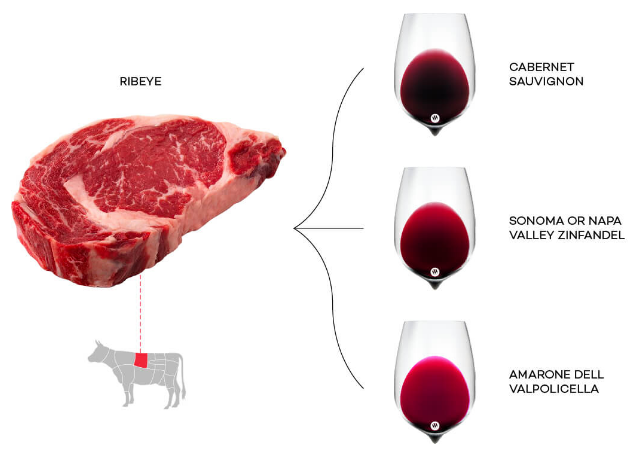
One of the most extravagant and most delicious cuts of steak. Loads of marbling and normally delicate, the Ribeye excels on the drier intensity of a hot barbecue. The Bone-in verison keeps overall similar guidelines, however, is sliced to the width of the still appended rib-bone, making it trickier to cook well.
Wines to Pick:
Cabernet Sauvignon: Pairs well with a rosemary dish cook.
Sonoma or Napa Valley Zinfandel: If you’re doing Ribeyes on the barbecue.
Amarone della Valpolicella OR Valpolicella Superiore Ripasso: Rich and smoky, yet with cherry-driven natural product.
Why they work: The higher fat substance makes for a rich, greasy flavor and requires either high tannins to eliminate the excess or a more grounded organic product flavor for contrast.
Sirloin
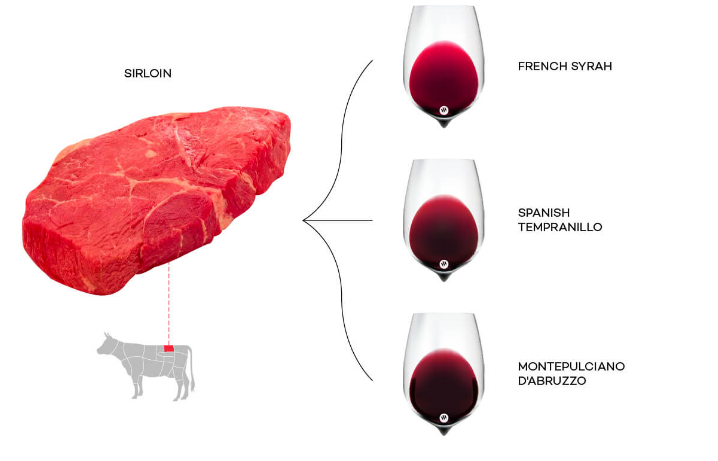
One of the most widely recognized steak cuts, genuinely inclined with light fat marbling and is frequently cut with a piece of fat along the edge. Sirloin should be possible on the barbecue, in the broiler, or container – yet its beams on the barbecue.
Wines to Pick:
Spanish Tempranillo: Try a matured Rioja Reserva.
Montepulciano d’Abruzzo: Look for this Italian pillar from Colline Teramane for additional quality.
French Syrah: Pairs well with spread sauces. Really look at the districts in the Northern Rhône (Saint-Joseph or Crozes-Hermitage for better worth and Cornas or Côte-Rôtie for genuine quality.)
Why they work: The Sirloin is a work-horse cut that can be prepared or sauced in a lot of ways, so we’ve meant to give adaptable wines that can match anything bearing you’re taking, yet focus on how your flavoring changes the dish and pick appropriately.
Porterhouse and T-Bone
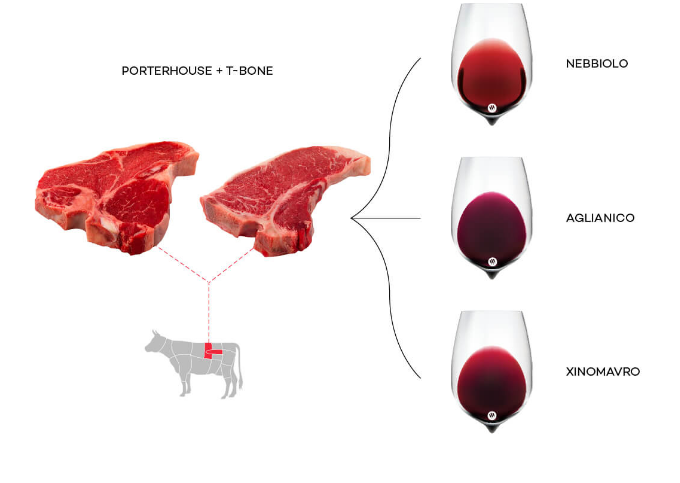
While the Porterhouse and T-Bone are marginally various cuts, the two of them have the delicious mix of a delicate filet side and a firmer, delightful strip side. Should be possible in a skillet, yet the barbecue is normally simpler to keep the cook even.
Wines to Pick:
Nebbiolo OR Barolo: Stylish, sweet-smelling red with grippy tannins from Northern Italy. Most certainly the hotshot choice.
Aglianico: Rich red from Italy’s south with very substantial flavors. In any case, when added to a substantial steak, this wine conveys an unadulterated organic product!
Xinomavro: (“Ksee-no-mah-Iroh”) An extremely delightful red-organic product flavor-driven by sweet-smelling Greek red. Search for wines from Naoussa and Amyndeon.
Why they work: The cuts on both the Porterhouse and T-Bone are delicate, yet entirely genuinely lean. Sweet-smelling and delightful reds will supplement their blend of filet and strip.
Filet Mignon
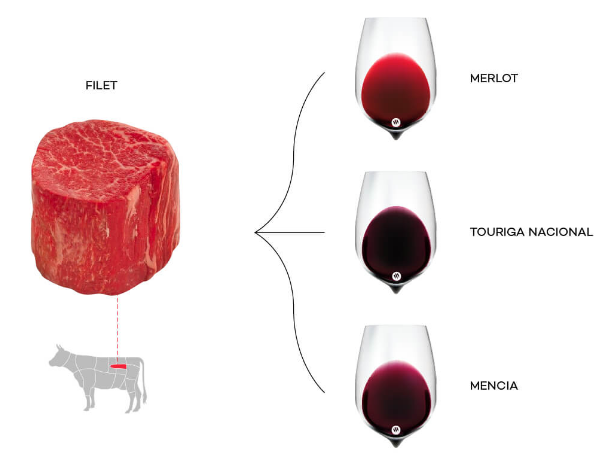
The Cadillac of steak cuts – unquestionably lean, yet entirely delicate and delightful. Frequently presented with sauces yet additionally a decision planning with a straightforward flavoring of salt and pepper. Dish burned and spread treated for the success.
Wines to Pick:
Merlot OR a Merlot-based red mix: Try one from Bordeaux or Washington State
Touriga Nacional: Coming from Portugal, this most unfathomable fruity red offers inconspicuous flower notes of violet. An extraordinary decision for steak au poivre.
Mencía: (“Men-you yah”) An exquisite choice from the Northern pieces of Spain with tart red berry notes and minerality.
Why they work: The Filet has an inconspicuous flavor and these wines focus on front and center, conveying reciprocal flavors that help with bringing out everything in this cut and try not to offend it.
Strip
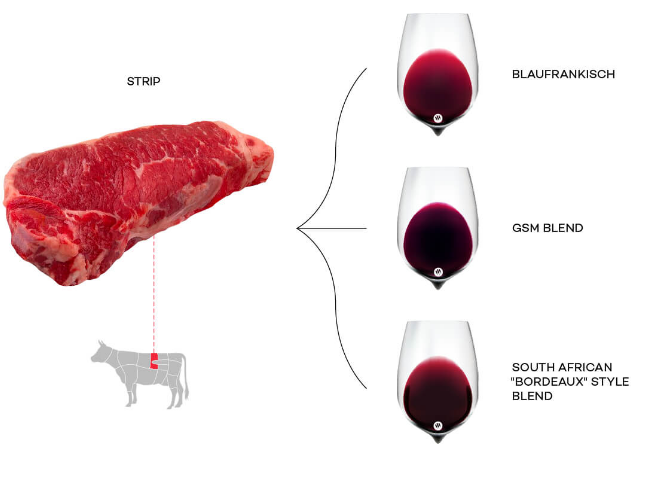
A famous decision for worth and flavor, the Strip stops by many names (New York Strip, shell steak, Kansas City strip) and a portion of those names are the aftereffect of somewhat various cuts whether there’s actually bone-in. Yet, with everything taken into account, you’re getting a short flank cut.
The cut has more connective tissue, however, it’s as yet a scrumptious cut and delicate when cooked appropriately. Do it up in a cast-iron dish, salted, seasoned with spread, and let it rest somewhat longer.
Wines to Pick:
Blaufränkisch: This odd-named grape is one of Austria’s and Germany’s most significant reds. Quality models offer dark cherry notes, great causticity, and a sweet smoky completion.
The GSM Blend: A mix that incorporates Grenache Syrah Mourvèdre – Known generally from the Rhône Valley in France, including the renowned Châteauneuf-du-Pape sub-locale.
South African “Bordeaux” style mix: South Africa’s 500 million-year-old terroir gives its Merlot-Cabernet mixes this unmistakable dusty quality with refined tannins. They’re natural product forward and hearty simultaneously.
Why they work: The Strip is delightful and a thicker grain cut of hamburger, making it valuable for a few distinct strategies for cooking, yet it needs a wine that can supplement the flavor AND slice through the fat. Our wine decisions have solid natural products alongside corrosiveness and tannins that take care of business.
Flank & Skirt
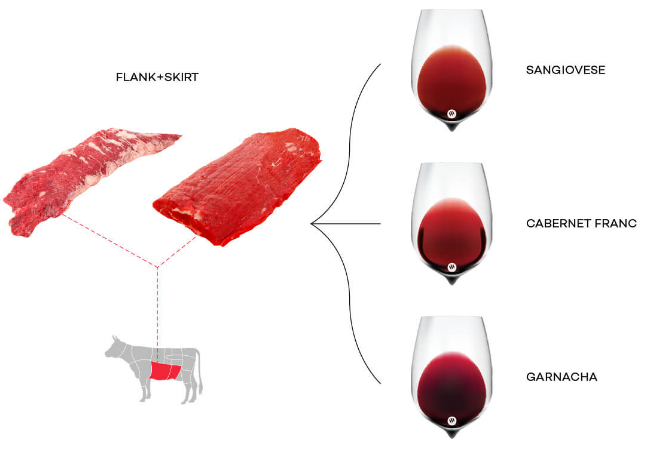
In no way, shape, or form a typical illustration of steak, Brisket is as yet commendable consideration in the potential steak pairings. This is one sliced that takes to low and slow cooking, particularly on a smoker, similar to no other. In the event that you don’t have a smoker, perhaps go get one (carry on with a bit!).
Your wine determination will be educated by what sort of fuel is in the smoker – we suggest wood chips, yet there are numerous to look over and each grants something scrumptious and specific. Hickory is the most well-known suggestion for brisket.
Wines to Pick:
Sagrantino: An intriguing red from Italy’s Umbria area. Wines are close hazy with strong dark natural products with mouth-covering tannins. Sagrantino will make brisket a tasteful undertaking.
Modest Sirah: An incredible smoky and rich choice from the United States that has huge tannins that slice through the substantial extravagance of brisket and grill easily.
Australian Shiraz: A smoother choice with somewhat less tannin that brings smokiness and blueberry-blackberry notes.
Why they work: Nearly all planning of a Brisket will bring about some smokey flavor and these wines supplement and improve smokiness.
Rump
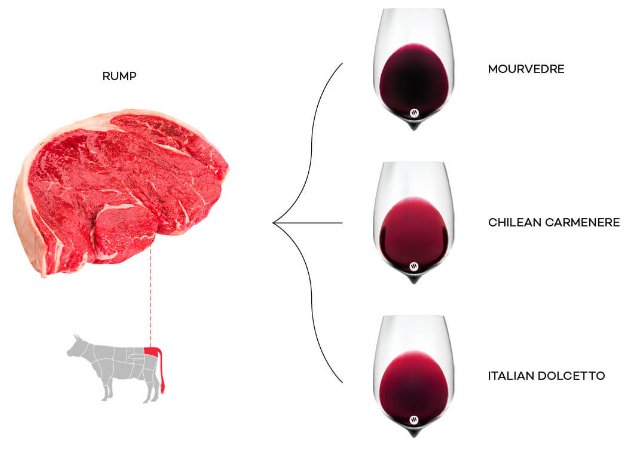
Posterior comes from a harder working muscle, making it firm yet additionally exceptionally delightful. It can profit from marinating, however, that can lose your wine choice.
Wines to Pick:
Mourvedre (also known as Monastrell): Look for something from Bandol, France, or Spain. Extraordinary peppery wine that is vigorous enough for truly substantial flavors.
Chilean Carménère: An example for steak fries or for a steak finished off with chimichurri sauce.
Italian Dolcetto: A most unimaginable berry enhanced wine with delicate sharpness and high tannins. An extraordinary decision for assuming that you’ve marinated your rear-end steaks.
Why they work: Since Rump is ready in numerous ways to beat the firm surface, we have a couple of determinations that can uphold your cook. Remember your sauces while matching and for different pieces of the dinner.
Flank and Skirt
While not completely the equivalent, both Flank and Skirt can be cooked with a similar procedure. They’ll marinate well, which makes them ideal for fajitas, yet assuming that you’re hoping to keep your meat-eating experience simply Steak, they should be possible on the barbecue with salt and pepper to prepare.
Wines to Pick:
Sangiovese: Try Chianti Classico, Vino Noblie de Montepulciano or Montefalco Rosso – the causticity and red organic product flavors slice through the chewiness.
Cabernet Franc: For an all the more sweet-organic product smoky style, focus on the US and Argentina. Make a beeline for France to the Chinon district, for a herbaceous Cabernet Franc, assuming you’re serving close by greens.
Garnacha: Another Spanish red for more red berry natural product flavors and liveliness that will effortlessly cut through chewy steaks.
Malbec: Strong berry flavor and smooth surface supplement the more sinewy cut and solid kind of the meat, and lower causticity wines will not experience the ill effects of the lean cut.
Why they work: It’s significant not to overcook or probably you’re eating shoe-cowhide, however even done flawlessly these cuts are harder. Our wines plan to supplement delightful however chewy meat, taking it from a task to an appetizing encounter.